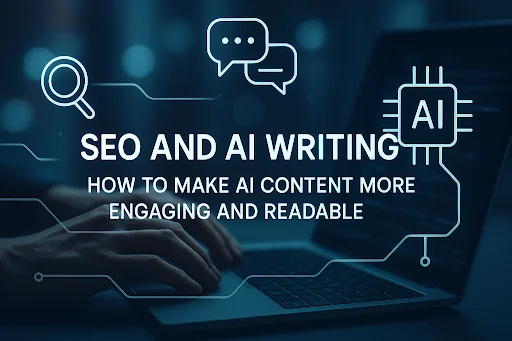SEO and AI Writing: How to Make AI Content More Engaging and Readable

In 2025, AI generated content is the norm, not the exception. 88% of marketers are now using AI to create content and 93% are using it for writing tasks. That said, here’s the reality: most AI writing doesn’t connect. The words look right, but they don’t feel human. Audiences are trained to see the difference between AI-generated content and a human touch, and to choose the latter. The difference isn’t if you use AI, but how you use it.
Search engines are no longer just about matching keywords. Now, they look for Experience, Expertise, Authoritativeness and Trustworthiness (E-E-A-T). AI writing struggles to show these traits, and so often ends up with a lower SEO ranking. But the good news is, with the proper usage, AI can help you create better content, and I will outline how in this article.
What Makes AI Content So Flat?
AI content is formulaic. According to GPTZero’s 2025 report, there are certain phrases you can look for in the content that was generated by AI. For example, phrases such as “provide a valuable insight” occur 468 times more frequently in AI content than content generated by humans. Other phrases like “left an indelible mark” were 317 times more frequent in AI generated content.
It’s not just about the phrases used. It’s also about the lack of engagement. AI output tends to rely heavily on the passive voice and third-person point of view. The problem is, it’s very hard for people to connect with something that’s written in a passive voice or third-person point of view. It feels impersonal. It feels like someone reciting information from a textbook, rather than having a conversation. It’s impersonal, and it doesn’t help your SEO performance either.
The problem is, search engines can detect content that feels copy-pasted. If your content doesn’t feel human, it won’t rank well. That’s because it’s difficult for search engines to pick up the markers that indicate that it’s human content. And that’s exactly what GPTHumanizer(https://www.gpthumanizer.ai/) does: it provides content with markers that make it human.
The Art of Humanizing AI Text
It starts with knowing your voice and your audience. Before you feed a prompt to an AI generator, you need to know what your voice and tone is. Are you formal or informal? Technical or accessible? This will influence the words you use. The problem with generic prompts is that they produce generic outputs. So instead of saying “write about solar energy”, you could say something like: “Explain the benefits of solar energy in a conversational tone for homeowners concerned about their electricity bill, using real-world examples.” The more specific you are, the better the result. For example, if you want readers to feel excited rather than just informed, you can specify that in the prompt.
You can also prompt an AI to be slightly different, say by using analogue instead of factual data, or vice versa. You can also prompt AI to provide real-world examples that make the text more engaging. One marketer that I’m aware of used transcripts from conversations with his customers as prompts. In this way, the content was tailored more towards real painpoints, rather than ones that he assumed their customers had.
The editing process is what makes good content great. Don’t just publish AI-generated content as-is. Use the CRAFT method: Cut fluff so the content is more engaging, Review the language so it sounds human, Add your own thoughts or stats with citations, Fact-check so you don’t publish hallucinated content, and build Trust by reflecting your authentic voice. This is what I do to transform AI-generated content into high-quality web copy. Usually, it means cutting out a lot of the fluffy phrases, injecting my own voice and perspective, and fact-checking everything.
Optimizing AI Content for Search Engines
Keywords are important but context is even more important. Modern SEO is moving beyond keyword density to more semantic relevance. With the help of AI tools you can find out the main keywords and LSI terms for a text but you will have to double check these with actual user intention. Tools that mine the SERPs to tell you what currently ranks, will give you an idea of what the winning formula is in terms of structure and content coverage.
Readability is an important part of SEO as it is a direct metric that affects rankings. A seventh to eighth grade reading level is ideal for general content. Technical content can push up a grade or two. Tools that use Hemingway style check on your text point out overly complex sentences and give you suggestions for simplification. Search engines also use readability algorithms to calculate if a text is accessible. When GPTHumanizer AI(https://www.gpthumanizer.ai/) processes your text it will try to optimize the readability while preserving the technicality, keywords and user intent.
FAQ sections should be placed in strategic positions. Using data from Google “People Also Ask” sections you can generate questions that will reflect actual user inquiries. Answer these questions in 40-50 words, then add more if you need to. This structure is good for many reasons; it caters to voice search queries, gives an answer to people who skim and it can also lead to a featured snippet. FAQ sections are good for placing at the end of an article as a resource section.
Internal linking is important for both the user journey and for technical SEO. When AI produces content, it has no idea about your existing pages. Add three to five contextual internal links pointing to other relevant articles or supporting content. This will keep users on your site longer and help search engines understand the site structure and topical relevance. Avoid using click here or similar phrases as your anchor text; instead try to give a glimpse of what the user will find if they follow the link.
Measuring Success and Tweaking
Analytics are the best way to see if your humanization efforts help. You should also look at engagement metrics other than traffic numbers. Things like average time on page, scroll depth and bounce rate. If people leave after 15 seconds of reading, your opening didn’t do the job. If they leave after scrolling 25% through, the middle didn’t do the job. These are two places on the page that need to be rethought.
A/B testing can be a great way to see what actually works. Take two similar pieces of content and do them in different tones or different styles and see if one does better than the other. See which does better in terms of conversions, or people staying on the page longer, or getting shared on social media. One company found that content written in a conversational first person did better than the more formal third person structure that they had been using by 40% in that niche, which goes against the advice that was available at the time.
User feedback can be a great way to get insights that an algorithm can’t. See what people are saying on social media, or in comments or in person. If someone tells you “this finally made sense” or says “I don’t understand this part” you’ve found an area that needs to be tweaked. And you can loop this back in and build better content through iterative tweaking.
Moving Forward with Confidence
The future of content creation isn’t about choosing between human or AI writers – it’s about strategically combining the human and AI strengths. AI is great for research, first draft and scaling up content production. You as the human bring the knowledge, emotional intelligence and human voice to turn ordinary text into an experience that is unforgettable. Pick one article, start using these techniques in a systematic way and see how it goes. It’s all about the process: readers don’t care whether or not AI wrote your first draft. They do care whether your content answers their questions, doesn’t waste their time and feels as if it was written just for them. The secret is knowing the humanization process. This will allow you to reap the benefits of AI and yet still deliver real business results.
Frequently Asked Questions
How can I tell if the content was written by AI?
Content written by AI tends to reuse phrases, uses transition words like moreover and furthermore too often and doesn’t have any personal stories. It tends to use the passive voice and a formal tone. AI content detectors look at word usage patterns and sentence structure, but these can be overcome through humanization.
Does Google penalize content written by AI for SEO?
No. Google is concerned with content quality and if that content will help people, not with how that content was written. Content written by AI will still rank poorly if it’s thin, unhelpful and lacks expertise. Quality matters whether it’s written by a human or AI, so it must be reviewed by experts.
What makes content written by AI sound robotic?
Using the same sentence structures too often, using transition words like moreover and furthermore too often, using the passive voice too much and not having the personal perspective that humans naturally have. Humans have nuance, senses of humor and cultural references that AI lacks. The result is technically correct but robotic text.
How long does it take to humanize content written by AI?
It takes about 30-50% of the time it would take if you were writing the content yourself. For roughly 1000 words, you should budget 15-20 minutes to fact-check, add personal stories, adjust the tone and improve the structure. If it’s a technical topic, you’ll also need to invest time to fact-check, which could be more or less than the time it takes to write it yourself.
Can content written by AI and then humanized still rank as well as content written by a human?
Yes. Search engines do not know what method was used to create the content. They simply care about the quality and relevance of the content. Content created by AI and then humanized can be as good, if not better, than content created by human.

Business Checking Account Options for Modern Entrepreneurs

Why Businesses Require Inspection of an LPG Tank

Cost of Private 5G and Private LTE Networks: What Should Businesses Choose

Accelerating drug discovery through the DEL-ML-CS approach

AI in Marketing Is No Longer a Buzzword — It’s the Strategy

Why BCA Students Should Explore AI and Machine Learning Specializations

SEO and AI Writing: How to Make AI Content More Engaging and Readable

How to Choose the Right AI Tool for Your Business








